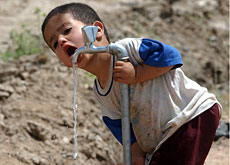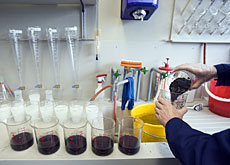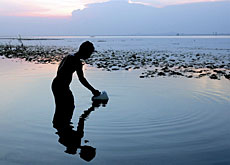Experts address world’s water needs

Specialists from 140 countries, including Switzerland, are meeting in Stockholm to assess progress on meeting the main water challenges facing the planet.
Among the issues being discussed during World Water Week are climate change, access to safe drinking water, management of resources and sanitation.
One of the eight Millennium Development Goals (MDGs) is to halve the number of people without access to safe drinking water and basic sanitation by 2015.
But according to a report published by the United Nations earlier this year, 600 million people will miss the sanitation target if current trends continue.
Christian Zurbrügg, head of water and sanitation in developing countries (Sandec) at the Swiss Federal Institute of Aquatic Science and Technology, says there is increasing commitment from governments to tackle the problem but much remains to be done.
“I don’t think it’s a bleak picture. People realise that in sanitation we’re not on track, but there is a momentum, which is quite positive. The commitment is there,” he told swissinfo.
Year of Sanitation
Zurbrügg, who is attending the week-long conference, said sanitation was still not seen as a “sexy issue” – a situation he hopes will change with the International Year of Sanitation in 2008.
While some countries were on course to achieving the millennium goal, others were in a worse position than in 2000, he noted.
“Sanitation always lags behind when it comes to the issue of water and sanitation. Yet some 2.6 billion people lack access to basic sanitation and that’s more than double the amount of people who don’t have access to water,” he explained.
“And if you look at the health aspects, excreta and inadequate wastewater management are one of the major factors of diarrhoeal disease.”
Another issue the Swiss have been looking at is water treatment and water quality. The millennium goal stipulates access to “safe” drinking water but Zurbrügg says supplies from treatment plants in developing countries are often contaminated before they reach homes.
Drinking water
Scientists at the Federal Institute of Aquatic Science and Technology have been working on so-called “point-of-use systems”, which would treat water for drinking once it gets there.
“In a way it doesn’t make sense to treat all the water a household uses,” said Zurbrügg.
Sandec, which has an annual budget of SFr4.5 million ($3.7 million) a year, has been developing low-cost solar water disinfection systems destined for rural communities and semi-urban areas. Around SFr2.5 million of the budget flows to research partners and projects in developing countries.
Vessela Monta, executive director of the Geneva-based International Rainwater Harvesting Alliance, who is also in the Swedish capital, said the problem of water sustainability in the face of climate and demographic change was also a big concern.
“We try to avoid talk of a water crisis because this is not the case globally. There are zones that are water stressed and there are zones where the situation is getting worse,” she said.
“In these areas there is growing awareness of the need to prevent a mass migration of the population and to find ways of delivering water and improving living conditions.”
She added that a key challenge was achieving a balance between reducing water consumption while also maintaining quality of life and ensuring economic growth.
swissinfo, Adam Beaumont
According to the UN, 20% of the world’s population in 30 countries face water shortages. This number is expected to rise to 30% of the world’s population in 50 countries in 2025.
The average European uses 200 litres of water every day. North Americans use 400 litres. The average poor person in the developing world uses ten litres of water every day for their drinking, washing and cooking, says the Water Supply and Sanitation Collaborative Council.
Only eastern, southeastern and western Asia, northern Africa and Latin America and the Caribbean are on track to halve the proportion of people without basic sanitation by 2015.
All other developing regions have made insufficient progress towards this target. In sub-Saharan Africa, the absolute number of people without access to sanitation actually increased – from 335 million in 1990 to 440 million people by the end of 2004. This number may increase even further if trends do not improve.
The health, economic and social repercussions of open defecation, poor hygiene and lack of safe drinking water are well documented. Together they contribute to about 88 per cent of the deaths due to diarrhoeal diseases – more than 1.5 million – in children under age five.

In compliance with the JTI standards
More: SWI swissinfo.ch certified by the Journalism Trust Initiative


You can find an overview of ongoing debates with our journalists here. Please join us!
If you want to start a conversation about a topic raised in this article or want to report factual errors, email us at english@swissinfo.ch.